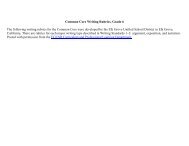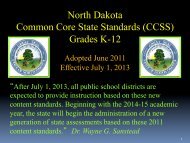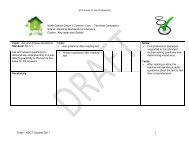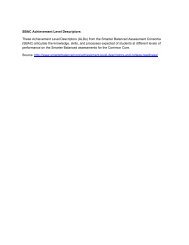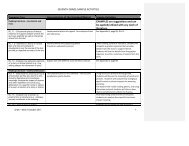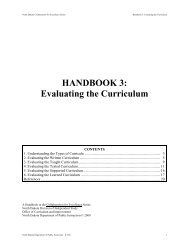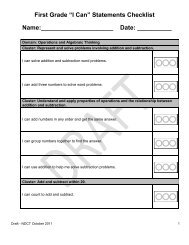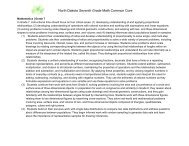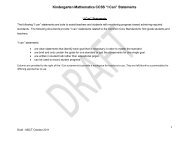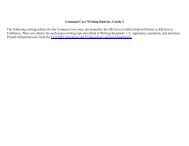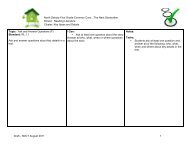A. ND Mathematics Content Standards, Grade 5 - ND Curriculum ...
A. ND Mathematics Content Standards, Grade 5 - ND Curriculum ...
A. ND Mathematics Content Standards, Grade 5 - ND Curriculum ...
Create successful ePaper yourself
Turn your PDF publications into a flip-book with our unique Google optimized e-Paper software.
such as digital content located on a website, and use them to pose or solve problems. They are able to use technological tool s to explore and deepen their<br />
understanding of concepts.<br />
6. Attend to precision.<br />
Mathematically proficient students try to communicate precisely to others. They try to use clear definitions in discussion with others and in their own<br />
reasoning. They state the meaning of the symbols they choose, including using the equal sign consistently and appropriately. They are careful about<br />
specifying units of measure, and labeling axes to clarify the correspondence with quantities in a problem. They calculate acc urately and efficiently, express<br />
numerical answers with a degree of precision appropriate for the problem context. In the elementary grades, students give carefully formulated<br />
explanations to each other. By the time they reach high school they have learned to examine claims and make explicit use of definitions.<br />
7. Look for and make use of structure.<br />
Mathematically proficient students look closely to discern a pattern or structure. Young students, for example, might notice that three and seven more is<br />
the same amount as seven and three more, or they may sort a collection of shapes according to how many sides the shapes have. Later, students will see<br />
7 × 8 equals the well remembered 7 × 5 + 7 × 3, in preparation for learning about the distributive property. In the expression x 2 + 9x + 14, older students<br />
can see the 14 as 2 × 7 and the 9 as 2 + 7. They recognize the significance of an existing line in a geometric figure and can use the strategy of drawing an<br />
auxiliary line for solving problems. They also can step back for an overview and shift perspective. They can see complicated things, such as some<br />
algebraic expressions, as single objects or as being composed of several objects. For example, they can see 5 – 3(x – y) 2 as 5 minus a positive number<br />
times a square and use that to realize that its value cannot be more than 5 for any real numbers x and y.<br />
8. Look for and express regularity in repeated reasoning.<br />
Mathematically proficient students notice if calculations are repeated, and look both for general methods and for shortcuts. Upper elementary students<br />
might notice when dividing 25 by 11 that they are repeating the same calculations over and over again, and conclude they have a repeating decimal. By<br />
paying attention to the calculation of slope as they repeatedly check whether points are on the line through (1, 2) with slope 3, middle school students<br />
might abstract the equation (y – 2)/(x – 1) = 3. Noticing the regularity in the way terms cancel when expanding (x – 1)(x + 1), (x – 1)(x 2 + x + 1), and (x –<br />
1)(x 3 + x 2 + x + 1) might lead them to the general formula for the sum of a geometric series. As they work to solve a problem, mathematically proficient<br />
students maintain oversight of the process, while attending to the details. They continually evaluate the reasonableness of t heir intermediate results.<br />
North Dakota <strong>Mathematics</strong> <strong>Content</strong> <strong>Standards</strong><br />
Based on the Common Core State <strong>Standards</strong><br />
Introduction 7 June 2011



